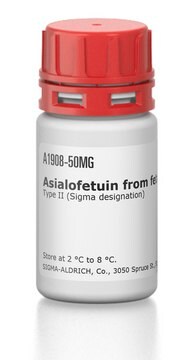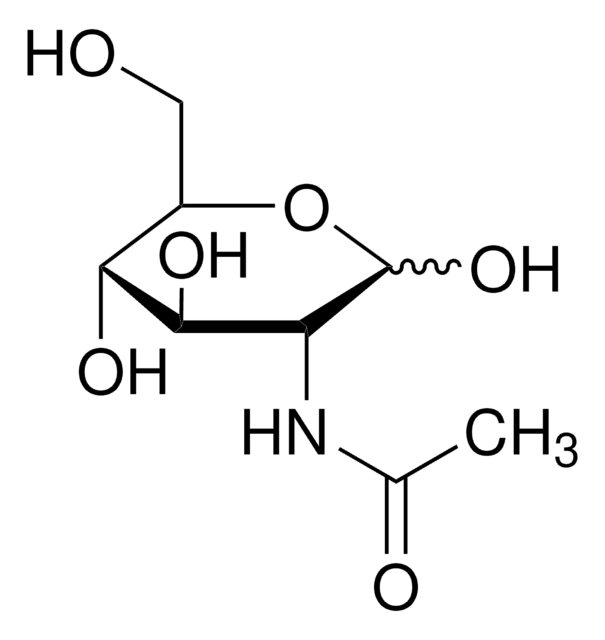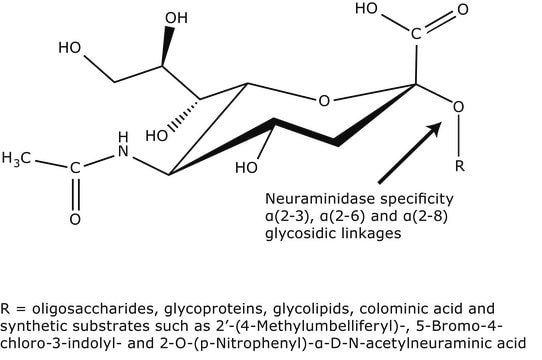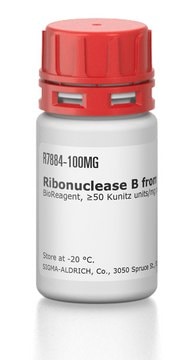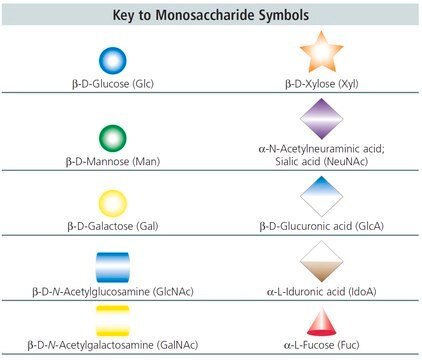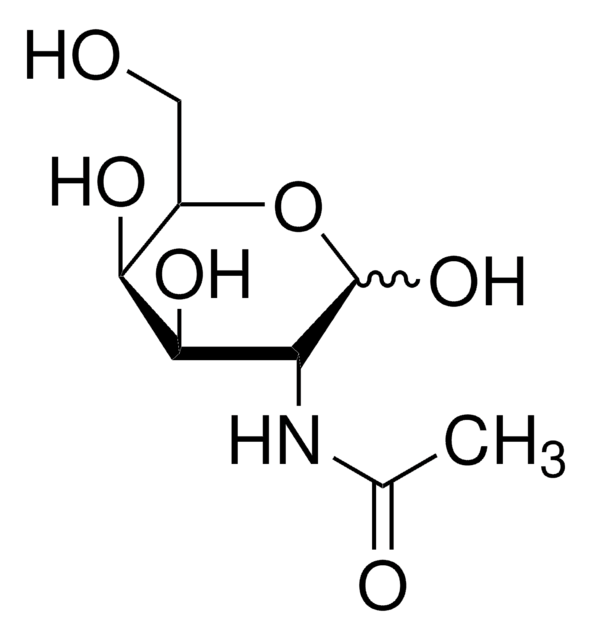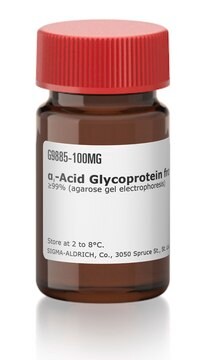A4781
Asialofetuin from fetal calf serum
Type I (Sigma designation)
Sinonimo/i:
Asialofetuin
Autenticatiper visualizzare i prezzi riservati alla tua organizzazione & contrattuali
About This Item
Prodotti consigliati
Origine biologica
bovine (calf) serum
Livello qualitativo
Tipo
Type I (Sigma designation)
Stato
powder
Impurezze
salt, essentially free
≤0.5% N-acetylneuraminic acid
Solubilità
0.85% sodium chloride: soluble 1 mg/mL
Temperatura di conservazione
2-8°C
Cerchi prodotti simili? Visita Guida al confronto tra prodotti
Descrizione generale
Asialofetuin is a glycoprotein with three asparagine-linked triantennary complex carbohydrate chains and terminal N-acetylgalactosamine residues.
Applicazioni
Asialofetuin from fetal calf serum has been used:
- to quantitate the plant Ricin toxin′s B subunit (RTB) lectin activity in β-phaseolin signal peptide (P)–proinsulin gene (INS)–RTB plants by enzyme-linked immunosorbent assay (ELISA)
- quantitate VP7:RTB fusion protein in transformed potato tissues by ELISA
- as a glycoprotein substrate to measure the receptor-binding activity of recombinant RTB and NSP490–RTB fusion proteins
- to study the nature of the interaction between ferritin and the placenta
Incorporation of asialofetuin (AF) in liposomes strongly enhance delivery to and endocytosis by cells displaying the AF receptor, notably hepatocytes. This provides a very efficient route for gene therapy.
Azioni biochim/fisiol
Asialofetuin exhibits affinity to asialoglycoprotein receptor (ASGP-R) on hepatocytes and uses the receptor to enter the cell. This property allows asialofetuin to be used as a ligand to deliver drugs to hepatocytes and as a competitive inhibitor to ASGP-R.
Nota sulla preparazione
Prepared by a modification of Spiro, R.G., J. Biol. Chem., 235, 2860 (1960).
Codice della classe di stoccaggio
11 - Combustible Solids
Classe di pericolosità dell'acqua (WGK)
WGK 3
Punto d’infiammabilità (°F)
Not applicable
Punto d’infiammabilità (°C)
Not applicable
Dispositivi di protezione individuale
Eyeshields, Gloves, type N95 (US)
Scegli una delle versioni più recenti:
Possiedi già questo prodotto?
I documenti relativi ai prodotti acquistati recentemente sono disponibili nell’Archivio dei documenti.
I clienti hanno visto anche
Keiichi Motoyama et al.
Journal of drug delivery, 2011, 476137-476137 (2011-04-15)
The purpose of this study is to evaluate in vitro gene delivery mediated by asialofetuin-appended cationic liposomes (AF-liposomes) associating cyclodextrins (CyD/AF-liposomes) as a hepatocyte-selective nonviral vector. Of various CyDs, AF-liposomes associated with plasmid DNA (pDNA) and γ-cyclodextrin (γ-CyD) (pDNA/γ-CyD/AF-liposomes) showed
R D Lamparelli et al.
British journal of haematology, 72(1), 100-105 (1989-05-01)
The organ distribution of intravenously injected hepatic ferritin either labelled with 59Fe or with 59Fe and 125I, was studied in pregnant guinea-pigs. At 5 h 71.2% of injected 59Fe was present in the placenta and fetus. Transfer of 59Fe to
Nida Zaidi et al.
International journal of biological macromolecules, 103, 65-73 (2017-05-13)
The SDS-glycoprotein system is mimic of membrane protein-lipid system. Fate of glycoprotein, conformation and the interactive forces involved in membrane milieu are expected to be decided by the net charge on glycoprotein that may change during acidic environment in a
Jakob Meier-Credo et al.
Journal of the American Society for Mass Spectrometry, 33(7), 1293-1302 (2022-06-28)
Identification and sequence determination by mass spectrometry have become routine analyses for soluble proteins. Membrane proteins, however, remain challenging targets due to their hydrophobicity and poor annotation. In particular small membrane proteins often remain unnoticed as they are largely inaccessible
Nak-Won Choi et al.
Journal of biotechnology, 121(2), 272-283 (2005-09-27)
The castor-oil plant Ricinus communis A-B dimeric toxin B subunit (RTB) was genetically linked at its N-terminus with a 90 amino acid peptide from simian rotavirus SA-11 non-structural protein NSP4(90) and produced in Escherichia coli BL21 cells. Biologically active recombinant
Il team dei nostri ricercatori vanta grande esperienza in tutte le aree della ricerca quali Life Science, scienza dei materiali, sintesi chimica, cromatografia, discipline analitiche, ecc..
Contatta l'Assistenza Tecnica.

